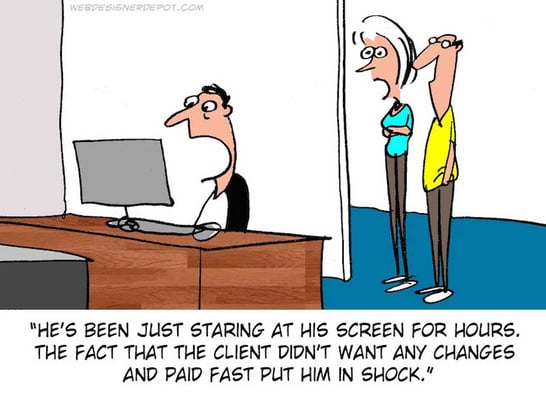April 15, 2019
 by Daniella Alscher / April 15, 2019
by Daniella Alscher / April 15, 2019

When I was growing up, pinky promises were highly respected.
Unfortunately, pinky promises aren’t widely accepted in the business world. That’s why having a graphic design contract is so important for someone who’s becoming a freelance graphic designer.
A graphic design contract is important for a graphic design freelancer because it is not only a promise to the client regarding what will be given to them, but also serve as a protection for the designer and their hard work.
While agencies and in-house graphic designers may have the benefit of access to a company lawyer or an HR team, freelancers are on their own. Ideally, you’ll never have a problem with a client. Better safe than sorry, right?
As you’ll find out quickly, no two clients are alike. Some clients are super easy to work with, while others may not email you back for a week. Some clients want a small, monochromatic logo, while other clients seem like they’ve pulled their ideas from outer space. Some clients may be happy with the final result, and other clients will ask for revision upon revision.
How can you possibly come up with a template for a contract that fits all of them?
The answer is...you can’t. Every client’s needs are different, and therefore each individual should have a contract curated to those needs.
 Source: Jerry King
Source: Jerry King
But that doesn’t mean we can’t start with the basics. Your graphic design contract should always have a few key things to make sure that both you and your client are protected.
| TIP: Use contract management software to create contracts with ease using customizable templates. |
We’ve heard the phrase “there are three sides to every story: yours, mine, and the truth.” This adage can be applied to why it’s important to have a graphic design contract. With one, there’s no questioning who’s right or who’s wrong; it’s all black and white.
This clause is simply a brief abstract of what’s to come below. Briefly explain what the client is requesting of you as well as exactly what you will be providing the client in the end.
You and your client have probably talked about this project quite a bit: sizes, elements, colors, you name it. You feel like you can see the final project before you even get started because you know the details of it inside and out. Why would you need to say it again?
Having this section in writing will ensure that you and your client are on the same page when it comes to expectations and your responsibilities.
This could also be a place to include what your responsibilities aren’t. For example, if you create a logo for a company and they later decide they want to implement it into their website, you don’t want to be held responsible for learning how to code that in. Are you getting paid extra to take the time to learn that? Not if it’s not detailed in this section.
Hopefully, your client is going to get something out of this.
The deliverables section will detail what you’re going to be providing your client with. Simple as that.
In this section, you’re going to want to list every single thing. The more specific, the better, especially if your client is a little picky.
By including this section, you’re outlining exactly what the client will be getting from you and how they’ll be getting it. Include whether you’ll be sending files via email or flash drive, as well as exactly what file types you’ll be offering. Whichever method of delivery and file type you choose, make sure you and your client agree.
If you’re designing in a program that your client doesn’t have and that’s how you send the files over, there’s going to be a problem.
If you like money, you’ll like this section.
Unfortunately, this area of the contract can’t just be writing out “$100.00 please” and then moving on. There are a few details of which you should be mindful.
First and foremost, it’s important to use the payment section to write out when you expect payment and in what form you want to receive it in. Designers should typically be paid before the client receives the final product(s).
This is also a good place to ask for a deposit, as freelance graphic designers often do. This deposit will lessen the chance of you not getting paid at all and will keep the client invested in you and your work.
That’s the simple stuff, but there are also a few clauses you could add if you really want to think things through.
Everyone loves a second chance.
Permittance of revisions means that you’ll allow your client to suggest changes to the design you’ve created for them.
Freelance graphic designers may not get the project right on the first try. Clients and designers often have different visions, which is why it’s good to give things a second chance. Or a third chance. But how many chances are you going to give?
Revisions should be a subsection of the payment section of a graphic designer’s contract so that you can make the client aware of whether or not you charge for revisions, and what you consider a revision to be.
Sometimes, a designer will do something like include up to two revisions in their initial price, and then charge a certain amount for every revision following.
Surprises can be fun. Being surprised with a party is fun. Being surprised with a million dollars is fun, too. But not all surprises are fun.
| DEFINITION: Unforeseeable circumstances that could prevent someone from fulfilling a contract. |
Force majeure refers to a situation beyond the designer’s control (a surprise) that stops them from completing the contract on time. These surprises could include anything from a stranger spilling coffee on your laptop to a tsunami.
While it’s not required, neither is an entire contract. But here we are, so we might as well include it. While we can always hope for the best, incorporating this into your contract gives you extra protection in case something does happen.
This is a subsection of the payment clause because depending on the situation, the project may be need to be delayed or terminated completely. If this is the case, you need to inform the client of what will happen with their money. Should they be paying you for the work that you’ve done? Will you refund them their deposit? Outlining this can save both parties a lot of trouble if something happens that’s out of your control.
Time is a tricky thing, especially when it comes to design.
In this area of the contract, you should be including your working hours and any agreed-upon deadlines.
To keep you in check!
Establish a deadline for not only the project itself, but for every step that it takes to get to your final destination. Not only will these dates keep you organized and motivated, but they’ll also give your client a little peace of mind knowing what you’re working on and when to expect some results. Remember to give yourself a little slack when determining these deadlines so that you’re not constantly pressed for time.
Including your working hours will (hopefully) prevent clients from contacting you when you’re trying to catch some Zs.
Another element to include in this section should be some dates that you’ll be checking in with your client for feedback. These dates could prevent millions of back-and-forth emails because they’ll set an exact time for you and your client to sit down and discuss what’s been done so far, what changes to make, and what next steps are. The amount of check-ins is up to you and should depend on the size and difficulty of the project
Hopefully you won’t have to have 10 check-ins for a logo, but it’s up to you.
Designers love to toot their own horns.
The work you produce your clients is work you should be proud of! This section refers to receiving credit where credit is due when it comes to your design.
If you don’t include this section, you technically may not have the right to showcase your work in your portfolio or on social media. The consequences of this are obvious, but I’ll spell it out for you: no work samples means very few (or no) clients.
Under the copyright law, you have fair use rights to show the final result of your project in your portfolio. If this is not written out in your contract, your client may not understand and ask that you not share your work for them anywhere that is associated with you. If this section isn’t in your contract, you’ll have to comply.
Unless you’re looking for a lawsuit.
| TIP: Take some time to learn the difference between copyright vs trademark before writing up your contract, as it may not apply to every project you work on. |
Intellectual property will explain the rights that each party (designer and client) has in regards to the final product.
When the designer finishes the project, whose property is it? Is it the designer’s because it was created by them? Is it the client’s because they’ve paid for it? In the IP clause, you’re going to get that straightened out.
AIGA’s Standard Form of Agreement for Design Services provides four different options for intellectual property ownership of the final product.
Sometimes, we let things slip.
Including a section regarding confidentiality will bind both the client and designer in a mutual agreement that any information that should be private regarding business matters will not be made public.
Working closely with a client can sometimes lead to the exposure of private information. Including this will prevent both you and your client from sharing any knowledge that the other does not share, therefore protecting both parties.
Some things are best kept secret.
Good ol’ John Hancock.
This is the pinky of the pinky promise that is your contract.
Without it, nothing is real. Leave a space for both yourself and your client to sign and date, showing that you both agree to the details above.
Sometimes, a signature with a pen can take a while. Freelancers may work with clients they never meet face-to-face. Using e-signature software is a great way to grab a legally binding signature without any ink.
Contracts are complicated, but one with all of these components is bound to be bulletproof. As a freelance graphic designer, you want to make sure that both you and your client are on the same page and hold each other accountable. There’s simply no better way to do it.
Didn’t know you needed law skills to be a graphic designer? You don’t. But you can learn more about the graphic design skills you absolutely need to succeed.
Daniella Alscher is a Brand Designer for G2. When she's not reading or writing, she's spending time with her dog, watching a true crime documentary on Netflix, or trying to learn something completely new. (she/her/hers)
Good artists borrow; great artists steal.
 by Daniella Alscher
by Daniella Alscher
Standing out from the crowd is a great feeling.
 by Daniella Alscher
by Daniella Alscher
There’s no doubt about it: graphic designer’s resumes can look awesome.
 by Daniella Alscher
by Daniella Alscher
Good artists borrow; great artists steal.
 by Daniella Alscher
by Daniella Alscher
Standing out from the crowd is a great feeling.
 by Daniella Alscher
by Daniella Alscher


